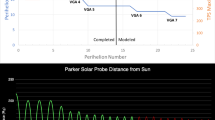Abstract
The problem of (dc) magnetic field energy build up in the solar atmosphere is addressed. Although large-scale current generation may be due to large-scale shearing motions in the photosphere, recently a new approach was proposed: under the assumption that the magnetic field evolves through a sequence of force-free states, Seehafer (1994) found that the energy of small-scale fluctuations may be transferred into energy of large-scale currents in an AR (the α-effect). The necessary condition for the α-effect is revealed by the presence of a predominant sign of current helicity over the volume under consideration. We studied how frequently such a condition may occur in ARs.
On the basis of vector magnetic field measurements we calculated the current helicity B z · (▽ × B) z in the photosphere over the whole AR area for 40 active regions and obtained the following results:
-
(1)
In 90% of cases there existed significant excess current helicity of some sign over the active region area. So one can suggest that the build up of large-scale currents in an active region due to small-scale fluctuations may be typical in ARs.
-
(2)
In 82.5% of cases, the excess current helicity in the northern (southern) hemisphere was negative (positive).
The method proposed can be applied to those ARs where the determination of the predominant sign of current helicity by traditional visual inspection of Hα-patterns is not reliable.
Similar content being viewed by others
References
Abramenko, V. I., Gopasyuk, S. I., and Ogir, M. B.: 1991, Solar Phys. 134, 287.
Ai, G.: 1987, Publ. Beijing Astron. Obs. 9, 27.
Ai, G., Li, W., and Zhang, H.: 1982, Chin. Astron. Astrophys. 6, 129.
Ding, Y. J., Hong, Q. F., and Wang, H. Z.: 1987, Solar Phys. 107, 221.
Gary, G. A. and Hagyard, M. J.: 1990, Solar Phys. 126, 21.
Hagyard, M. J., Smith, J. B., Teuber, D., and West, E. A.: 1984, Solar Phys. 91, 115.
Hale, G. E.:1927, Nature 119, 708.
McIntosh, P. S.: 1979, Upper Atmosphere Geophysics Report UAG-70, World Data Center A for Solar-Terrestrial Physics, Boulder.
Nakagawa, Y., Raadu, M. A., Billings, D. E., and McNamara, D.: 1971, Solar Phys. 19, 72.
Richardson, R. S.: 1941, Astrophys. J. 93, 24.
Rust, D.M. and Kumar, A.: 1994, in Proc. of the Third SOHO Workshop - Solar Dynamic Phenomena and Solar Wind Consequences, European Space Agency SP-373, p. 39.
Seehafer, N.: 1990, Solar Phys. 125, 219.
Seehafer, N.: 1994, Astron. Astrophys. 284, 593.
Wang, J., Shi, Z., Wang, H., and Lu, Y.: 1995, Astrophys. J. (in press).
Wang, T., Xu, A., and Zhang, H.: 1994, Solar Phys. 155, 99.
Zhang, H. and Wang, T.: 1994, Solar Phys. 151, 129.
Author information
Authors and Affiliations
Rights and permissions
About this article
Cite this article
Abramenko, V.I., Wang, T. & Yurchishin, V.B. Analysis of electric current helicity in active regions on the basis of vector magnetograms. Sol Phys 168, 75–89 (1996). https://doi.org/10.1007/BF00145826
Received:
Revised:
Issue Date:
DOI: https://doi.org/10.1007/BF00145826




